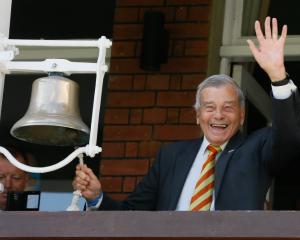He stands just 1.70m tall and he can no longer be described as a left-handed batsman.
Meet David Warner, the dashing and diminutive Australian opening batsman who might be the prototype of the modern cricketer.
Warner, who will have the New Zealand bowling attack on edge in the first twenty/20 international in Wellington tomorrow night, is the talk of the sport after his switch-hitting against the West Indies on Tuesday night.
During his innings - 67 runs from just 29 balls - Warner switched to a right-handed stance when facing spinner Narsinghe Deonarine.
He was later warned by umpire Rod Tucker for contravening the "spirit of cricket", the much-treasured if occasionally blurry set of values to which the game is supposed to adhere.
"The umpire said it wasn't in the spirit of the game," Warner said after Tuesday night's game.
"I argued the point about [bowlers] going over and around the wicket.
We have to try and adapt to that, so why can't the fielding team adapt to me batting both ways?"
The switch-hitting issue first arose two years ago when England batsman Kevin Pietersen, a right-hander, smashed two sixes after switching to a right-handed stance in a game against New Zealand.
Some wondered whether it was fair, given bowlers have to advise the umpire on which side of the crease they intend to bowl.
But Pietersen's daring move got the unlikely backing of the Marylebone Cricket Club, the keeper of the Laws of Cricket.
"The MCC believes that the switch-hit stroke is exciting for the game of cricket," the club said in a statement at the time.
"It conforms to the Laws of Cricket and will not be legislated against."
The MCC said switch-hitting was a risky move by the batsman, so "it also offers bowlers a good chance of taking a wicket and therefore the MCC believes that the shot is fair to both batsman and bowlers".
The only mention of batting stance in the Laws of Cricket refers to the off side of the wicket being established according to the batsman's stance "at the moment the ball comes into play for that delivery".
This raises the interesting problem of whether to call a wide if the ball travels down what would have been a batsman's leg side had he not changed his stance.
Warner won't have such quandaries on his mind.
He has one plan: to hit the ball as hard and as far as possible.
He did it against the West Indies, he did it on his twenty/20 debut against South Africa last year (89 off 43 balls) and he will do it to the Black Caps if he gets a chance.
Peter Roebuck, the respected cricket columnist, summed up Warner's status last year when he became the first Australian since 1877 to represent his country without first playing first-class cricket for his state.
"Warner's charge reveals the changing dynamics of the game.
"It has changed the balance of power between cricketers and officials, it is changing attitudes and techniques," Roebuck wrote.
"Warner has talked about using both sides of the bat and belting the ball out of the park.
"It's not so long ago that young batsmen focused on footwork.
"Of course the basics remain the same but the brain has been liberated."
David Warner
Mr Ambidextrous
Age: 23
Province: New South Wales
ODI record: Seven games, 106 runs, average 15.14
T20 record: Eleven games, 413 runs, average 37.54, strike rate 152.39
First-class record: Four games, 131 runs, average 26.20
Law 36.3 of the Marylebone Cricket Club's Laws of Cricket states:"The off side of the striker's wicket shall be determined by the striker's stance at the moment the ball comes into play for that delivery."
There is no specific law pertaining to batting stance.












